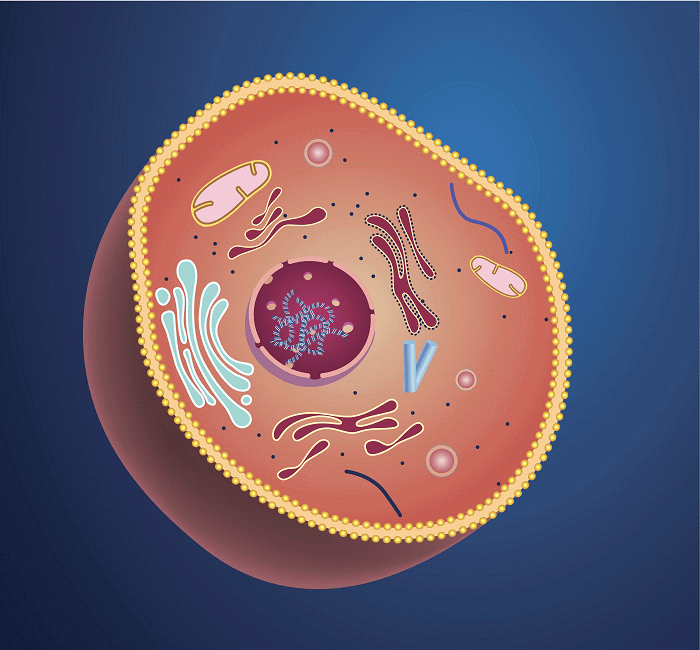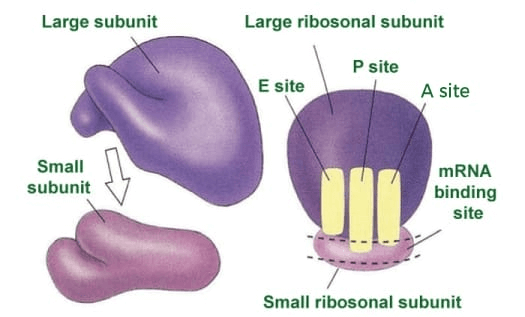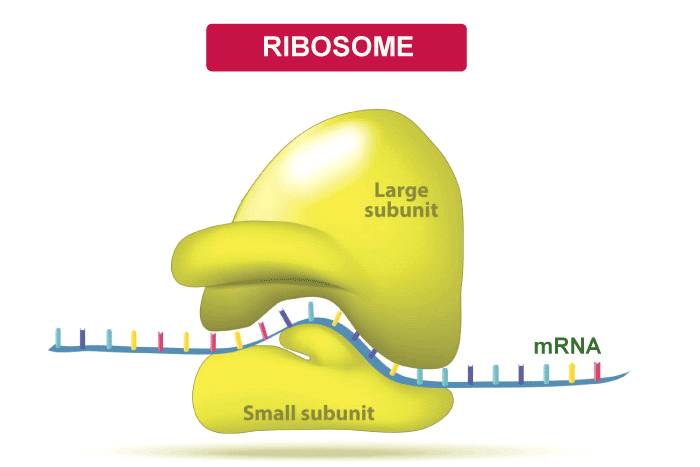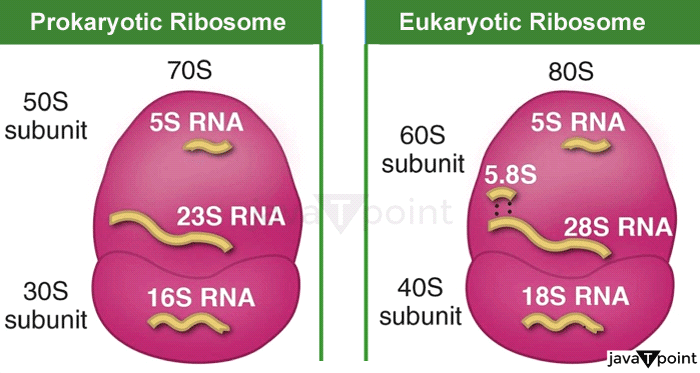Ribosomes DefinitionRibosomes are small, sub-spherical ribonucleoprotein particles that lack a membrane and play a crucial role in protein synthesis. They can be found in various parts of the cell and were first isolated from the cytoplasm by A. Claude in 1943, who named them microsomes. Robinson and Brown observed ribosomes for the first time in plant cells during their microscopic study of bean roots in 1953. G.E. Palade discovered ribosomes in animal cells and named them Palade's particles. Further research has exposed more details regarding the processes of these organelles in the cells. Ribosomes are seen in both connected to the endoplasmic reticulum (ER) and nucleus, as well as freely in the chloroplasts, cytoplasm, and mitochondria. An Overview of RibosomesRibosomes are small organelles found in the cytoplasm, mitochondria, and endoplasmic reticulum that help convert genetic code into chains of amino acids through protein synthesis. They are composed of RNA and protein and play an active and indispensable role in all living cells. 
The mRNA binds to a protein called a ribosome, which helps decode the nucleotide sequence. Another type of RNA, tRNA, then adds amino acids to the protein chain in the ribosome. Ribosomes are crucial cell organelles made of RNA and protein that aid in translating genetic code from mRNA into amino acid chains, known as protein synthesis or translation. Important Characteristics of Ribosomes
OccurrenceRibosomes can be discovered in both Prokaryotic and Eukaryotic cells, with Prokaryotic ribosomes generally spread throughout the cytoplasm. Ribosomes in eukaryotic cells are either free in the cytoplasm or bound to the endoplasmic reticulum (ER) and nucleus membrane. Illustrations of cells with free ribosomes include yeast, lymphocytes, and embryonic nerve cells, whereas pancreatic cells and hepatic parenchymal cells have bound ribosomes. Ribosomes attach to endoplasmic reticulum membranes for protein synthesis. Free ribosomes are sites for protein synthesis that are not attached to the endoplasmic reticulum and produce proteins used for intracellular storage and utilization. Shape and Number of RibosomesRibosomes are consistently shaped regardless of type, appearing as oblate spheroids. Prokaryotic ribosomes typically range in diameter from 17-21 nm and length from 20-29 nm. Eukaryotic ribosomes are 20-24 nm in diameter and 30-34 nm in length. Ribosomes are abundant in cells that produce proteins, including liver, pancreatic, endocrine, and meristematic cells. Ribosomes are present in eukaryotic cells and can number up to 500,000 but are scarce in starving or inactive cells. Ribosomes are abundant in cells, with E. coli containing 20,000-30,000. They are especially prevalent in cells that have ER (endoplasmic reticulum). Various types of cells, including yeast, gland, plasma and liver cells, nerve cells, and rapidly growing plant and animal cells, contain a significant amount of Ribosomes. Ribosome Structure
Ribosomes are made up of RNA, protein, metallic ions like Mg2+, and some lipids. The composition varies between the 70S and 80S ribosomes, with RNA making up approximately 65% in the former and 45% in the latter. Ribosomes are made up of a smaller and larger subunit, with the bigger subunit being responsible for adding amino acids and the smaller subunit decoding mRNA. The smaller subunit has 3 sites and a gap that splits the head from the base, while the larger subunit consists of three sites split by a valley.
Ribosome Chemical CompositionRibosomes are made up mostly of ribosomal RNA (rRNA), proteins and metallic ions. 
i) Ribosomal RNAsThe 70S ribosomes have mainly 3 sorts of rRNA such as 23S, 16S, and 5S. The larger subunit has the 23S and 5S rRNA, while the smaller subunit contains only the 16s rRNA. Ribosomes are composed mostly of ribosomal RNA, with prokaryotic ribosomes containing 66% and eukaryotic ribosomes containing 60%. The 80S ribosomes have four types of rRNA, with the larger subunit containing 28S, 5.8S, and 5S rRNA and the smaller subunit containing 18S rRNA. ii) Ribosomal ProteinsRibosomal proteins serve various functions, including basic, structural, and enzymatic. They are classified as S-proteins for smaller ribosomal subunits and L-proteins for larger ones. Ribosomes are ribonucleoprotein particles that contain an enzyme called peptidyl transferase which catalyzes the formation of peptide bonds. The rRNA remains attached to proteins within the larger ribosomal subunit. iii) Metallic IonsRibosomes contain metallic ions, including Mg2+, Ca2+, and Mn2+, along with rRNA and proteins. Ribosomes Types1. Prokaryotic RibosomesProkaryotic ribosomes are crucial in protein synthesis for prokaryotic cells. They have distinct characteristics that set them apart from eukaryotic ribosomes. Prokaryotic ribosomes are made up of two subunits, with the small subunit being 30S and the large subunit being 50S. These units are denoted by their Svedberg (S) values based on how quickly they sediment during centrifugation. Additionally, prokaryotic ribosomes contain three strands of rRNA: 16S RNA, 5S RNA, and 23S RNA. 2. Eukaryotic RibosomesEukaryotic ribosomes are larger than prokaryotic ribosomes and have two subunits, small (40S) and large (60S), which contain ribosomal proteins arranged on a scaffold of RNA. The small subunit checks the match between tRNA anticodon and mRNA while the large subunit catalyzes peptide bond formation. Is there any similarity between Prokaryotic and Eukaryotic Ribosomes?Ribosomes are vital parts of cells, and they play a crucial role in creating proteins. Although prokaryotic and eukaryotic ribosomes have structural and functional differences, they also share similarities that make them essential to cellular processes.
Difference between Prokaryotic and Eukaryotic RNA
Prokaryotic and eukaryotic ribosomes have some differences despite their similarities.
Other Different RibosomesThere are different types of ribosomes based on their location. Bacterial Ribosomes: These ribosomes have a sedimentation coefficient of 70S and are present in bacterial cells. Mitoribosomes: These are ribosomes found in mitochondria and come in different types depending on the organism. They are generally considered to be of the 70S variety, although mammals have 60S mitoribosomes while plants have 78S and fungi have 73S. Plastidoribosomes: Chloroplasts contain ribosomes known as plastidial ribosomes or plastidoribosomes. These are the 70S in higher plants. Nuclear Ribosome: Nuclear ribosomes are ribonucleoprotein particles found in the nucleus. Nucleolar Ribosomes: These are RNP particles found in the nucleolus that have a diameter of 150-200 �. Cytoplasmic Ribosomes: These are large particles found in the cytoplasm. Functions of RibosomesRibosomes are responsible for protein synthesis in cells, but prokaryotic and eukaryotic ribosomes play different roles in several ways. Prokaryotic ribosomes consist of the 30S and 50S subunits to form a 70S particle, while eukaryotic ribosomes have 40S and 60S subunits forming an 80S particle. Additionally, prokaryotes have three RNA strands compared to four in eukaryotes. Lastly, prokaryotic ribosomes exist freely within the cytoplasm, while eukaryotes can be found attached to nuclear and ER membranes as well as free in the cytoplasm. Ribosomes are a vital component of all living cells, with their principal function being protein synthesis. This process, called translation, involves the ribosome synthesizing proteins by reading mRNA sequences and translating them into amino acid chains. Ribosomes not only synthesize proteins but also transport proteins to their intended destinations within the cell. In addition to synthesizing as well as transporting proteins, ribosomes also contribute to numerous cellular processes. Free ribosomes in the cytoplasm synthesize proteins that assist in protoplasm formation, which is essential for cell development and division. Moreover, ribosomes act as catalysts during peptidyl transfer and peptidyl hydrolysis processes involved in peptide bond formation or breakdown. These catalytic activities are critical for many biological processes, such as metabolism regulation. Finally, newly synthesized polypeptide chains passing through the tunnel or channel of larger subunits of a ribosome remain protected against action from protein-digesting enzymes. Thus playing a protective role while ensuring proper folding of these chains before they reach their final destination within or outside the cell. ConclusionRibosomes are fascinating structures that play an indispensable role in the process of protein synthesis. They are composed of both RNA and proteins, which work together to create amino acid chains by reading messenger RNA sequences. This process involves the use of cellular accessories such as transfer RNAs and metabolic energy to initiate, elongate, and terminate peptide synthesis. Interestingly, ribosomes can be found in cells that produce proteins through translation. The translation is an essential biological process that occurs within cells where genetic information stored in DNA is used to create functional proteins necessary for proper cell function. Ribosomes facilitate this process by decoding the genetic information contained within mRNA molecules and using it to build complex protein structures. In addition to their crucial role in protein synthesis, ribosomes have also been implicated in numerous disease pathways. For instance, mutations or dysregulation of ribosome function have been linked with several types of cancer and other disorders characterized by abnormal protein production. Overall, while ribosomes may seem like simple structures, they play a critical role in maintaining cellular health and proper bodily functioning. FAQs1. What's Unique about Ribosomes?Ribosomes are responsible for making proteins by translating genetic code from mRNA into amino acids. They use additional cellular proteins, transfer RNAs, and energy to initiate, elongate, and terminate the process of peptide synthesis. 2. May Persons Survive without Ribosomes?Proteins are essential for cell processes and repair, and without them, cells cannot function properly. Ribosomes are necessary for synthesizing proteins, making life impossible without them in living organisms. 3. What is Bacterial Ribosome?The bacterial ribosome is a complex molecular machine that translates genetic information into proteins. It has a large size and intricate structure, with a diameter of 200-250 � and a molecular mass of 2.5 MDa. 4. Do Organisms Utilise Ribosomes?Ribosomes use mRNA to build proteins and enzymes in all living systems through a process called translation. The core of the ribosome is identical across all species. 5. Do Ribosomes Collaborate with Other Cells or Not?Ribosomes are essential organelles that produce proteins, acting like the bricks used to build a house. They follow orders from RNA and the nucleus, similar to how workers follow instructions from a foreman. 6. Do all cells share ribosomes?Ribosomes are present in all living cells and are accountable for protein synthesis. They exist as free particles in prokaryotic and eukaryotic cells or bound to the endoplasmic reticulum's membranes in eukaryotic cells.
Next TopicStock Exchange Definition
|
 For Videos Join Our Youtube Channel: Join Now
For Videos Join Our Youtube Channel: Join Now
Feedback
- Send your Feedback to [email protected]
Help Others, Please Share










